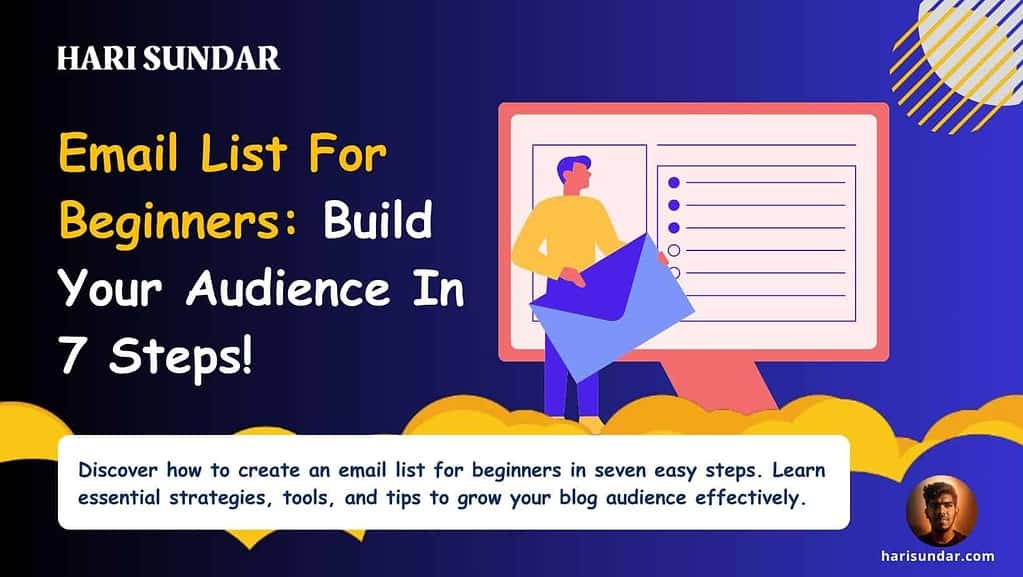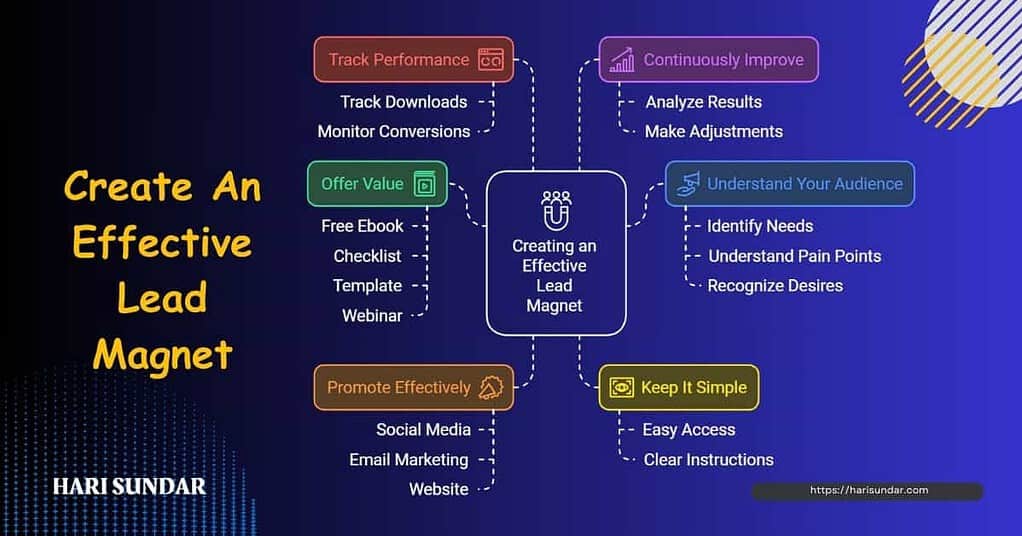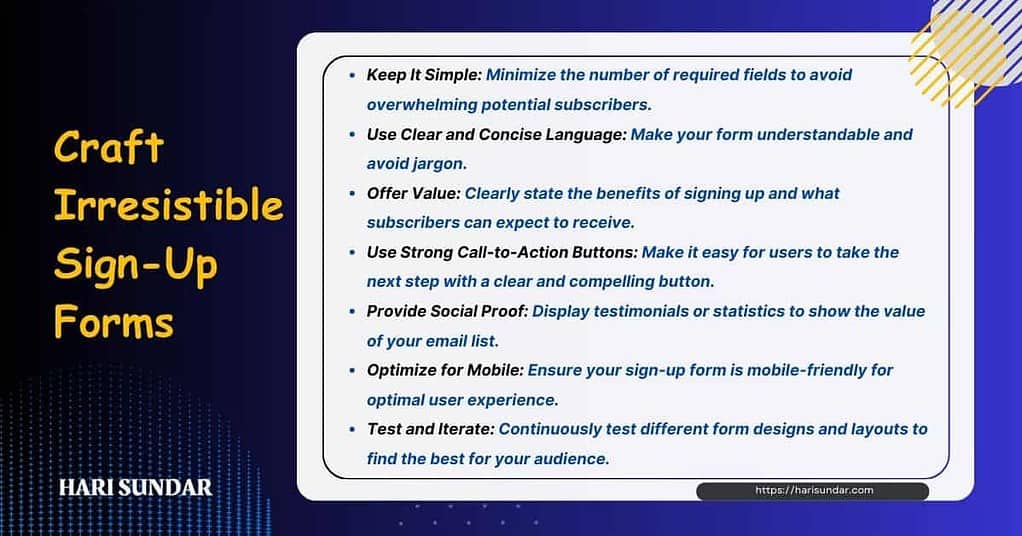Email List For Beginners: Build Your Audience In 7 Steps!

When I started my blog, my email list was as empty as my wallet after a tech shopping spree. But that barren list? It became my blog’s secret weapon.
Building an email list for beginners might sound as exciting as watching paint dry, but trust me, it’s the backbone of a thriving blog.
Whether you’re just getting started in blogging or you’re creating content full-time, your email list is your direct line to readers who want to hear from you.
In this guide, we’re cutting through the noise to give you the real deal on email lists. You’ll discover how to create an email list for beginners in seven easy steps.
No fancy jargon, no complex strategies – just straight talk from someone who’s been there, done that, and got the t-shirt (and a growing email list to boot).
TLDR: Your Email List Cheat Sheet 📧
- Why email beats social media hands down 🏆
- Snag subscribers with irresistible freebies 🎁
- Craft emails people want to open 📬
- Dodge rookie mistakes that cost you readers 🚫
- Pick tools that won’t make your brain hurt 🛠️
By the end of this post, you’ll be ready to turn casual readers into loyal subscribers. As you learn to blog, you’ll see firsthand the benefits of blogging with a solid email strategy. Let’s get started!
1. Email List For Beginners: Why You Need One?
Did you know that email marketing generates for every spent? That’s a 4,200% return on investment! (Source)
I couldn’t believe my eyes when I first stumbled upon this stat. But after diving into email marketing for my blog, I can vouch for its power.
Let’s face it, social media algorithms are about as predictable as a toddler’s mood swings. One day, your posts will reach thousands; the next, a big silence.
But emails? They quietly slip into inboxes, ready to be read at your subscriber’s convenience. No algorithm juggling is required.
Building an email list is like planting a garden that’s actually yours. Unlike renting space on Facebook or Instagram, your email list belongs to you.
When I started my blog, I shared my posts on social media, but I missed the opportunity to build an email list.
When platform changes hit, my reach tanked overnight. Don’t make my mistake—start your email list now.
The cool part is emails let you get personal without being creepy. You’re not shouting into the void; you’re chatting with readers who’ve invited you into their digital inboxes.
Turning casual readers into superfans is where email lists shine. Take Sarah, a food blogger I know. She started sending weekly recipe emails to her small list of 50 subscribers.
Six months later, her list grew to 5,000, and those loyal readers became her first cookbook customers. Talk about a recipe for success!
But here’s the million-dollar question: how do you start building this magical email list?
Stick around – in the next section, we’ll dive into choosing the perfect email service provider to kickstart your list-building journey.
2. Picking Your Email Sidekick: Choosing an ESP

When I first dipped my toes into email marketing, I felt like a kid in a candy store – overwhelmed by choices and unsure where to start.
But don’t worry, I’ve done the legwork so you don’t have to stumble around like I did.
Let’s talk about beginner-friendly email service providers (ESPs). Popular options like Mailchimp, ConvertKit, and MailerLite offer free plans to get you started.
Now, what features should you look for? Must-haves include:
- Easy-to-use email templates
- Automation capabilities (trust me, you’ll thank me later)
- Basic segmentation tools
- Analytics to track your progress
Remember, you don’t need all the bells and whistles right off the bat. Focus on tools that grow with you.
Pricing is where things can get tricky. Most ESPs charge based on subscriber count. As a newbie, stick to free plans or low-cost options under /month.
I learned the hard way that fancy features aren’t worth breaking the bank over when you’re just starting.
Compatibility with your blog platform is crucial. If you’re using WordPress like me, look for ESPs with easy integration options.
I wasted a whole weekend trying to connect an incompatible service to my site. Don’t be like past me – check compatibility first!
User-friendliness can’t be overstated. You want to spend time writing awesome emails, not wrestling with confusing interfaces.
If your Email Service Provider requires a PhD kind of thing to operate, then switch to one with a good user experience. Needless to say, I switched pretty quickly.
Choosing your ESP is like picking a sidekick for your blogging journey. Take your time, test drive a few options with their free trials, and find the one that feels right for you.
Curious about what to do once you’ve chosen your ESP? In the next section, we’ll dive into creating your first lead magnet – the secret sauce to attracting subscribers like moths to a flame.
3. Bait That Hooks: Creating Your First Lead Magnet

Think of a lead magnet as a digital catnip for your readers. It’s not some fancy fishing lure, but a free, valuable resource you offer in exchange for an email address.
So, what makes a killer lead magnet? It solves a specific problem for your audience. Here are some ideas that work wonders:
- Checklists or cheat sheets
- Mini-courses or email challenges
- Ebooks or guides
- Templates or swipe files
- Exclusive video tutorials
The key is relevance. I created a SEO checklist to collect emails and it worked because it directly helped my audience improve their blog posts.
Now, let’s talk about crafting a freebie that’s useful. Let’s say it is an e-book, write it straight to the point that actually helps the readers.
Because I have downloaded many e-books on productivity, many of them were around 50 pages long.
After I went through them I found that some of them contain more fluff than actual context. The 50-page ebook could’ve been summed up in 15 pages. Don’t be that guy.
So, focus on providing actionable, concise content. For example, if you’re in the fitness niche, a “5-Minute Ab Workout” guide is more enticing than a vague “Get Fit Fast” ebook.
Making your opt-in offer look snazzy doesn’t require a design degree. Tools like Canva offer templates that’ll make your lead magnet look professional in minutes.
I use Canva to create infographics and all my freebies and trust me, it’s a lifesaver for anyone who wants to create designs without any prior knowledge of designing.
Getting your lead magnet into eager hands is the final step. Place opt-in forms strategically on your blog – think sidebar, end of blog posts, and maybe a pop-up (use sparingly to avoid annoying readers).
Remember, your lead magnet is often a reader’s first impression of your content. Make it count!
Wondering where to put those opt-in forms for maximum impact?
Stick around for the next section, where we’ll discuss crafting irresistible sign-up forms that will have readers hitting “subscribe” faster than you can say “email list.”
4. Sign Me Up: Crafting Irresistible Sign-Up Forms

Let’s talk about turning your blog into a subscriber magnet. My sign-up form was hidden like a shy kid at a party when I first started. Big mistake.
Once I got strategic about placement, my list grew faster than my caffeine addiction during finals week.
Prime real estate for your forms:
- Top of your sidebar
- End of blog posts
- About page
- Resource page
- Footer
But here’s the kicker: it’s not just about where you put them, it’s what you say.
Your form copy needs to scream “value!” faster than a discount sign at a sale. Instead of boring “Subscribe for updates,” try “Get weekly SEO hacks to 10x your traffic!”
Now, the pop-up debate. Annoying or effective? Honestly, both. My first pop-up felt like I was slapping visitors in the face with a newsletter.
But a well-timed, value-focused pop-up? It doubled my conversion rate. The secret? Make it relevant and easy to dismiss. No one likes a clingy pop-up.
Exit-intent forms are like catching someone just before they leave the party. “Wait! Don’t forget your goodie bag!”
I use these to offer a content upgrade related to the post they’re reading. It’s like mind-reading, but less creepy and more helpful.
Testing your forms isn’t just for the tech geeks. It’s how you go from “meh” to “heck yeah!” in sign-ups. I use Google Optimize to A/B test everything from colors to copy.
Keep in mind, that your sign-up forms are like friendly invitations to join your email party. Make them impossible to resist!
5. Growth Hacks: Expanding Your Email Empire
Want to turn your blog into a subscriber-attracting powerhouse? Let’s dive into some growth hacks that won’t make you feel like a sleazy salesperson.
First up, transform your blog posts into subscriber magnets.
Sprinkle content upgrades throughout your articles – think checklists, templates, or exclusive tips related to the post topic. This targeted approach can boost sign-ups by up to 785%, according to Backlinko.
Social media can be your ally, not your enemy. Instead of constant “subscribe now!” posts, share snippets of your email content or tease exclusive offers. This gives followers a taste of what they’re missing.
Pinterest, for instance, is great for promoting lead magnets visually.
Never underestimate the power of word-of-mouth. Implement a referral program where subscribers earn rewards for bringing friends on board. It’s like having an army of marketers working for you.
Harry’s, the razor company, gathered 100,000 email addresses in a week with a clever referral campaign.
Teaming up with other bloggers can skyrocket your growth. Guest posting, joint webinars, or podcast appearances let you tap into established audiences.
Just ensure there’s a genuine value exchange – it’s not about leeching off others’ success.
Paid ads can be a double-edged sword. They’re great for promoting high-value lead magnets or time-sensitive offers.
However, skip them if you’re just starting or your budget is tight. Focus on organic growth first, then consider ads to amplify successful strategies.
Remember, growing your list isn’t about tricks – it’s about consistently providing value that people want to share.
Curious about what to do with all these new subscribers? Let’s explore how to turn them into superfans in the next section.
6. From Inbox to Superfan: Engaging Your Subscribers

You’ve got subscribers – now what? Let’s turn those email addresses into a community of engaged readers.
Your welcome email sets the tone for your entire relationship. Make it count. Introduce yourself, set expectations, and deliver immediate value. Maybe include a surprise bonus or your best piece of content.
Welcome emails have an average open rate of 82% – that’s prime real estate! (Source)
Segmentation is your secret weapon. Group subscribers based on interests, behavior, or demographics. Segmenting your users allows you to send targeted content that feels personally crafted.
A study by Mailchimp found that segmented campaigns get 14.31% more opens and 100.95% more clicks than non-segmented ones.
Planning saves sanity. Create an email calendar, outlining themes and key messages for each month.
Tools like Trello or Asana can help manage this. Having a plan prevents the dreaded “what do I send?” panic.
The golden rule of email marketing? Value first, promotion second. Aim for an 80/20 split – 80% valuable content, 20% promotion.
This builds trust and keeps subscribers looking forward to your emails, not dreading them.
Encourage replies to strengthen real conversations. Ask questions, run polls, or simply invite feedback.
This two-way communication turns subscribers into active participants. Plus, it’s a goldmine for content ideas and product development.
Remember, engaging your list isn’t about bombarding inboxes. It’s about building relationships, one valuable email at a time.
Wondering how to measure the success of your email efforts? In our next section, you’ll learn to track what matters in email marketing.
7. Numbers Game: Tracking What Matters

Let’s face it, diving into email stats can feel like trying to decipher ancient hieroglyphics. But trust me, once you know what to look for, it’s like having a crystal ball for your email strategy.
Here are the metrics that matter:
- Open rate: Are your subject lines doing their job?
- Click-through rate (CTR): Is your content compelling enough to click?
- Conversion rate: Are subscribers taking the desired action?
- Unsubscribe rate: Are you keeping readers engaged?
When I first started, I obsessed over every metric. Now, I focus only on these four and it’s making a big difference.
Tools can make tracking a breeze. Most email service providers offer built-in analytics but don’t overlook Google Analytics for tracking website conversions from emails.
Setting goals is crucial, but be realistic. When I aimed for a 100% open rate, I set myself up for disappointment.
Now, I set incremental goals. For instance, if my open rate is 20%, I’ll aim for 22% next month. Small wins add up!
Using data to level up your game is where the magic happens. Notice a drop in open rates? Maybe it’s time to spice up those subject lines. Low CTR? Your content might need a refresh.
Lastly, keep your list clean. An email list is like a garden – it needs regular weeding.
Remove inactive subscribers (those who haven’t opened emails in 3-6 months) to improve deliverability and engagement rates.
I do a list clean-up quarterly, and while it can be scary to see numbers drop, the improved engagement is worth it.
Remember, these numbers are your roadmap to email marketing success. Use them wisely, and watch your email game soar!
Conclusion
Building an email list isn’t just about collecting addresses – it’s about growing a community around your blog.
Every subscriber is a real person who’s raising their hand and saying, “Hey, I want to hear more from you!”
Don’t sweat it if your list starts small. Rome wasn’t built in a day, and neither was any successful email list.
The key is to start and to keep at it consistently.
Now, it’s time to take action. Pick an email service, create a simple lead magnet, and get that sign-up form on your blog.
Then, send your very first email. Each step you take is building the foundation for your blogging empire.
Ready to turn your blog into a reader magnet? Your email list journey starts now. Go on, send that first email – future you will be doing a happy dance!
FAQs: Email List For Beginners
How often should I send emails to my subscribers?
Start with once a week and adjust based on engagement. Quality trumps quantity. Pay attention to open rates and feedback. If you’re providing value, subscribers won’t mind hearing from you regularly.
Is it okay to buy email lists to grow faster?
Absolutely not. Buying lists is a recipe for poor engagement and potential legal issues. Focus on organic growth through lead magnets and valuable content. It might be slower, but you’ll build a loyal, engaged audience.
What’s the best time to send emails?
There’s no one-size-fits-all answer. Test different days and times with your audience. Generally, weekday mornings work well, but your subscribers might be different. Use your ESP’s analytics to find your sweet spot.
How do I write compelling subject lines?
Keep them short, specific, and intriguing. Use power words, ask questions, or create a sense of urgency. Avoid clickbait – your subject line should accurately reflect the email’s content.
What’s the ideal length for an email?
Aim for 200-300 words for most emails. Get to the point quickly and break up text with subheadings and bullet points. Longer emails can work for in-depth content, but make sure every word counts.
How can I reduce my unsubscribe rate?
Provide consistent value, segment your list to send relevant content, and don’t overdo the promotional emails. Make it easy for subscribers to update their preferences instead of unsubscribing completely.
Is it worth investing in email marketing tools?
Yes, if you’re serious about growing your list. Start with free plans and upgrade as needed. Good tools save time, provide valuable insights, and help you create more effective campaigns.




